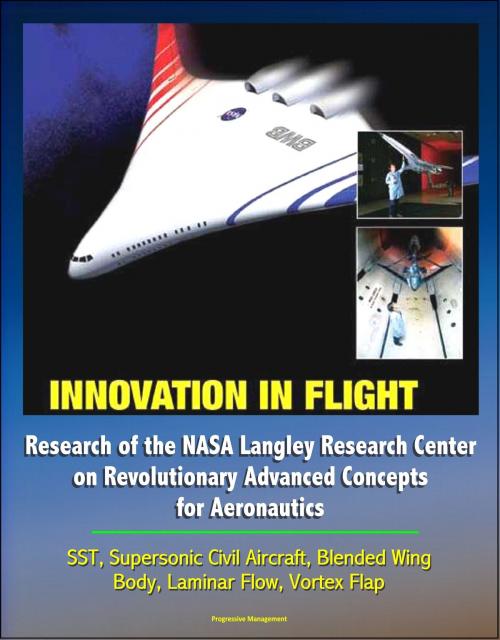Innovation in Flight: Research of the NASA Langley Research Center on Revolutionary Advanced Concepts for Aeronautics - SST, Supersonic Civil Aircraft, Blended Wing Body, Laminar Flow, Vortex Flap
Nonfiction, Science & Nature, Technology, Aeronautics & Astronautics, History, Military, Aviation| Author: | Progressive Management | ISBN: | 9781310042553 |
| Publisher: | Progressive Management | Publication: | May 3, 2015 |
| Imprint: | Smashwords Edition | Language: | English |
| Author: | Progressive Management |
| ISBN: | 9781310042553 |
| Publisher: | Progressive Management |
| Publication: | May 3, 2015 |
| Imprint: | Smashwords Edition |
| Language: | English |
Professionally converted for accurate flowing-text e-book format reproduction, this NASA publication provides an overview of the topic of revolutionary research in aeronautics at Langley, including many examples of research efforts that offer significant potential benefits, but have not yet been applied. The discussion also includes an overview of how innovation and creativity is stimulated within the Center, and a perspective on the future of innovation. The documentation of this topic, especially the scope and experiences of the example research activities covered, is intended to provide background information for future researchers.
Innovation: The Seed Corn of Tomorrow * Selected Examples of Langley's Research On Revolutionary Advanced Concepts * Supersonic Civil Aircraft * The Blended Wing Body * Synthetic Vision * Laminar-Flow Control * Upper Surface Blowing * Control of Aeroelastic Response * The Joined Wing * The Vortex Flap * Innovative Control Effectors * Personal Air Transportation Concepts * The Future of Innovation: Priming the Pump
The objective of this publication is to discuss the importance of innovation and the role of revolutionary advanced concepts within the aeronautics research community, and to provide information on typical advanced research projects conducted by Langley and its partners on topics that have not yet been applied by the military or civil aviation industry to production aircraft. Detailed information is first provided to describe each advanced concept, the projected benefits that could be provided if the technology is applied, and the challenges faced by the NASA research team to reduce the risk of application. Next, descriptions of specific research activities on the concepts identify the key projects, accomplishments, personnel, and facilities involved in the development of each concept. Finally, perspectives are provided on the current status of the subject concepts, including discussions of factors or future events that might intensify interest in their use for future applications. Many of the concepts described herein are subjects of ongoing NASA research thrusts, for which significant technical challenges are in the process of being addressed.
This document is intended to serve several purposes. As a source of collated information on revolutionary concepts, it will serve as a key reference for readers wishing to grasp the underlying principles and challenges related to specific revolutionary concepts. Hopefully, such information will provide valuable background that can serve as starting knowledge bases for future research efforts and minimize the so-called "reinvention of the wheel" syndrome. More importantly, the information identifies major obstacles to advanced aeronautics technology, thereby providing a sensitivity for multi-faceted research projects to ensure a higher likelihood of application. A definition of current barriers to application is extremely valuable for use in the future, when new breakthroughs in various technical disciplines may eliminate or minimize some of the critical barriers that have traditionally blocked the application of some of these specific revolutionary concepts. Finally, a review of the material will hopefully inspire the nontechnical (as well as technical) communities that aeronautics is not a "mature science" and that considerable opportunities exist to revolutionize the future.
The written material has been prepared for a broad audience and does not presume any significant technical expertise. Hopefully, it will provide informative and interesting overviews for researchers engaged in aeronautics activities, internal NASA policy makers, national policy makers, NASA stakeholders, the media and the general public.
Professionally converted for accurate flowing-text e-book format reproduction, this NASA publication provides an overview of the topic of revolutionary research in aeronautics at Langley, including many examples of research efforts that offer significant potential benefits, but have not yet been applied. The discussion also includes an overview of how innovation and creativity is stimulated within the Center, and a perspective on the future of innovation. The documentation of this topic, especially the scope and experiences of the example research activities covered, is intended to provide background information for future researchers.
Innovation: The Seed Corn of Tomorrow * Selected Examples of Langley's Research On Revolutionary Advanced Concepts * Supersonic Civil Aircraft * The Blended Wing Body * Synthetic Vision * Laminar-Flow Control * Upper Surface Blowing * Control of Aeroelastic Response * The Joined Wing * The Vortex Flap * Innovative Control Effectors * Personal Air Transportation Concepts * The Future of Innovation: Priming the Pump
The objective of this publication is to discuss the importance of innovation and the role of revolutionary advanced concepts within the aeronautics research community, and to provide information on typical advanced research projects conducted by Langley and its partners on topics that have not yet been applied by the military or civil aviation industry to production aircraft. Detailed information is first provided to describe each advanced concept, the projected benefits that could be provided if the technology is applied, and the challenges faced by the NASA research team to reduce the risk of application. Next, descriptions of specific research activities on the concepts identify the key projects, accomplishments, personnel, and facilities involved in the development of each concept. Finally, perspectives are provided on the current status of the subject concepts, including discussions of factors or future events that might intensify interest in their use for future applications. Many of the concepts described herein are subjects of ongoing NASA research thrusts, for which significant technical challenges are in the process of being addressed.
This document is intended to serve several purposes. As a source of collated information on revolutionary concepts, it will serve as a key reference for readers wishing to grasp the underlying principles and challenges related to specific revolutionary concepts. Hopefully, such information will provide valuable background that can serve as starting knowledge bases for future research efforts and minimize the so-called "reinvention of the wheel" syndrome. More importantly, the information identifies major obstacles to advanced aeronautics technology, thereby providing a sensitivity for multi-faceted research projects to ensure a higher likelihood of application. A definition of current barriers to application is extremely valuable for use in the future, when new breakthroughs in various technical disciplines may eliminate or minimize some of the critical barriers that have traditionally blocked the application of some of these specific revolutionary concepts. Finally, a review of the material will hopefully inspire the nontechnical (as well as technical) communities that aeronautics is not a "mature science" and that considerable opportunities exist to revolutionize the future.
The written material has been prepared for a broad audience and does not presume any significant technical expertise. Hopefully, it will provide informative and interesting overviews for researchers engaged in aeronautics activities, internal NASA policy makers, national policy makers, NASA stakeholders, the media and the general public.















